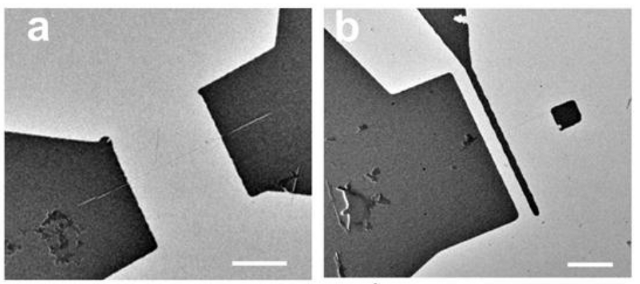
The phenomenon is familiar: if you run an electric current through a wire, the wire heats up. Known as "Joule heating" (for James Joule, the physicist-brewer who quantified it in the 19th century), the cause is usually very simple: the electrons carrying the current transfer some of their energy to the atoms in the wire, and the increased vibration of the atoms is measured as a rise in temperature. While it's very useful in some applications, Joule heating can often be a problem, especially in electronic devices like computer processors, where excess thermal energy can cook the chips.
A new experiment performed at the University of Maryland has produced Joule heating where the current is separated from the heat. Kamal H. Baloch, Norvik Voskanian, Merijntje Bronsgeest, and John Cumings determined that a current flowing in a carbon nanotube can transfer thermal energy into the material the tube is sitting on, a process they dub "remote Joule heating." In other words, there is a separation between the electric flow—confined to the nanotube—and increased heat, which ends up in the substrate, even though it carries no current. Using electron thermal microscopy, the researchers determined that as much as 84 percent of the power in the nanotube was transferred to the substrate, pointing to a possible new way to manage excess heat in electronics.
In nanoscale materials, it's challenging to determine exactly where heat is dissipating. Specifically, if you have a material measured in micrometers (millionths of meters), then the material is roughly the same size as infrared wavelengths, which means ordinary thermal imaging is not available. To solve this problem, the researchers used electron thermal microscopy (EThM), which scatters electrons off blobs of indium, a metal with a relatively low melting point. The indium's response to the electrons is different when it is liquid or solid, making its melting a sensitive indicator of temperature.
Baloch et al. constructed two similar devices to probe remote Joule heating. In the first, a nanotube was connected by both ends to palladium electrodes, so that current could flow the entire length of the tube. In the second, the electrodes were placed such that current only flowed through a short length of the nanotube. In both cases, the system sat on a substrate of silicon nitride (SiN) that also hosted a number of tiny blobs of indium.
By monitoring which blobs melted and which remained solid, they obtained a detailed thermal map revealing exactly where the heat was dissipating. If the system underwent normal Joule heating, the indium blobs around the nanotubes and electrodes should melt first. Instead, the researchers discovered that temperatures peaked at the center of the full-length nanotube; the palladium electrodes' temperature barely budged. Palladium, being a metal, is highly responsive to changes in temperature, so if the nanotube is hot, the palladium electrodes should also heat—yet this didn't happen.
When the current only ran through part of the nanotube (the second setup), ordinary Joule heating should increase the temperature of the entire tube. Instead, the indium only melted near the current-carrying portion, indicating that the nanotube itself wasn't heating up. Nanotubes are highly heat-conductive, so if one part is heated, the whole tube should rapidly reach the same temperature.
Both of these experiments demonstrated that the substrate was heating, but the nanotube and the electrodes were not. Since the nanotube wasn't in direct contact with the substrate, ordinary Joule heating cannot explain the phenomenon—the electrons in the current are not directly interacting with the atoms that undergo thermal vibrations. Instead, the researchers postulate that the electrons are passing the energy along via their electric field.
Since carbon nanotubes are capable of carrying very high density currents, Baloch et al. suspect this kind of remote heat dissipation could be very useful in future electronic devices. If the current-carrying parts of a device can transfer the thermal energy to a separate device, it should be possible to quickly dump heat that might otherwise damage the chip.
Nature Nanotechnology, 2012. DOI: 10.1038/nnano.2012.39 (About DOIs).
Listing image by Photograph by courtesy of John Cumings, University of Maryland
reader comments
6